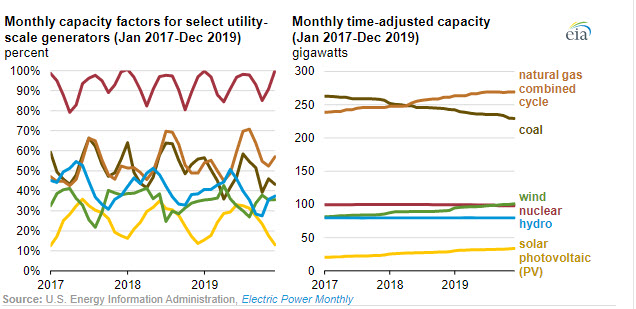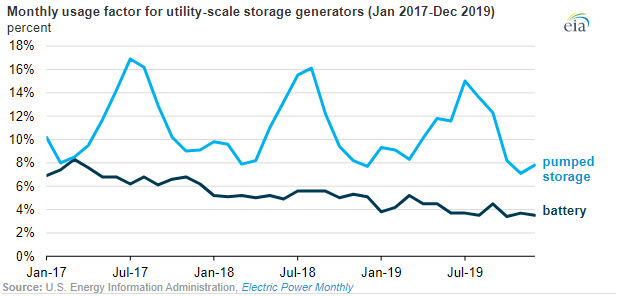Oil & Gas 360 Publishers Note: Interesting information from the EIA on power plants and electricity storage. The storage will be a huge market in the next several years, and investors should watch this portion of the energy sector.

The U.S. Energy Information Administration’s (EIA) Electric Power Monthly now includes more information on usage factors for utility-scale storage generators as well as a monthly and an annual series on the total available capacity for several power plant technology types.
Capacity factors measure how intensively a generating unit runs. EIA calculates capacity factors by dividing the actual electrical energy produced by a generating unit by the maximum possible electrical energy that could have been produced if the generator operated at continuous full power. A capacity factor of 100% means a generating unit is operating all of the time. Both parts of this calculation are based on generation and capacity values from other EIA surveys.
Previous EIA capacity factor tables contained monthly capacity factor data for 16 power plant technology types. The new capacity factor tables include time-adjusted total capacity values by technology, which account for monthly additions and retirements of each technology type. Generators that come online or are retired in a given month are excluded from that month’s calculation because EIA does not have information on their hours of operation within that month.

In October 2019, EIA started publishing gross generation data for battery and pumped storage applications in its detailed electric power survey. Another new table provides capacity factor data based on gross generation for pumped storage and batteries. Usage factors for storage generators differ from capacity factors because usage factors are based on gross generation rather than net generation. Energy storage technologies consume more energy than they store and, therefore, always have negative net generation.
Energy storage technologies provide value by storing electricity when electricity demand is low, often when prices are relatively inexpensive, then selling the stored electricity when electricity demand is high, and often prices are higher as well.
Pumped storage—which involves pumping water into a storage reservoir—is by far the largest source of electricity storage in the United States. Pumped storage’s usage factor generally follows the pattern of total electricity demand: a large peak in summer, a smaller peak in winter, and the lowest use in spring and fall. By comparison, the usage factors for batteries are relatively low and less seasonal. Many operators have installed battery storage systems recently to serve a variety of functions.
Principal contributors: David Darling, Sara Hoff
Tags: capacity, power plants, electricity, storage
[contextly_sidebar id=”XIJPyZcFdmxvHL6IbzYz7Sz76SShiSKH”]





